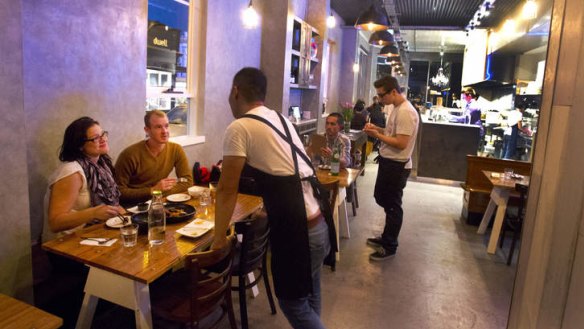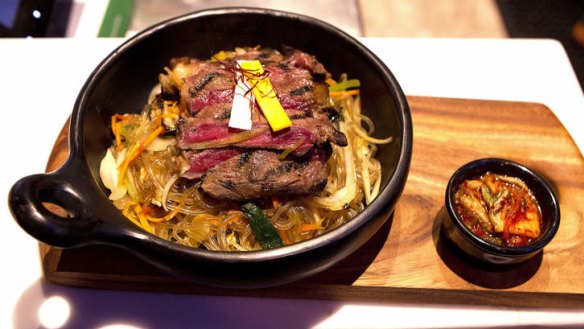Frying Colours

Korean
There were plans but before anyone lifted a tool on the construction of this five-week-old restaurant, owner-chef Min Hui Lee had the cabbage fermenting. It's often said that kimchi is the foundation of Korean food; here's proof.
Most Korean places serve kimchi as banchan - a complimentary side; here, it's $5, but for that you get a small mason jar full (finally, something served in a preserving jar for good reason)."My kimchi is influenced by my grandma," says Lee. "It's very chilli-driven." The batch we tried, now four months old, was spicy but not super funky. Unlike the handsomely finished fitout.
The open kitchen is clad in a rusty metal wash, and runs almost the length of the many-windowed dining room - energised by the grill's steam and sighs. Apart from the delicately dangling chandelier in the front window, it's all urban industrial, a mix of tin and cage lights, trestle-legged tables and glossy concrete and timber.

They say all those good microbes that result during the fermentation of kimchi help digestion, and I say it carries the health quotient of wicked dishes such as fried chicken. The free-range chicken pieces have been seasoned, then lightly battered and fried crisp; they're typically dry, until drenched in finger-lickin' sweet soy sauce.
Much on the menu comes off the gas-flame grill, including scotch fillet strips served on glassy sweet-potato noodles. The beef is quite heavy for the delicate noodles underneath. There's also flame-grilled pork belly, and chicken thigh. The bibimbap is the hot stone bowl variety, but it wasn't always. Lee originally served the other type - in a shallow dish - but customers bemoaned the lack of a crisp bottomed bibimbap, so Lee bought more burners - on which the stone pots sit to crisp up the rice within. The bibimbap is a vegetable colour wheel, with sections of green (zucchini), orange (carrot), yellow (beansprouts) and brown (shiitake), and a raw egg yolk at the centre, which you'll gleefully burst and stir through the rice and veg.
The menu is organised by ingredient to ''emphasise the ingredient-driven dishes'', says Lee. I found it a little counterintuitive when trying to balance a meal; if you want a dish from the grill and a lighter stir-fry, you have to file through chicken, beef, pork, veg and fish to find dish types. But it's not a big menu, so not a big problem.
Frying Colours' traditional Korean dishes have non-threatening, non-Korean names - such as ''sweet potato noodle'' (called ''japchae'' in Korean) - and simple, non-threatening spices. A few Koreanised now-classics, like bulgogi burger, keep things fresh. It's good looking, honest and willing to tweak its offerings to give customers what they want - solid foundations for a good local restaurant.
Do … Book
Don't … Like it too spicy? Don't worry
Dish … Grilled beef with sweet potato noodles
Vibe … Stylish Kensington meets Korea
Restaurant reviews, news and the hottest openings served to your inbox.
Sign up